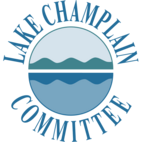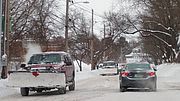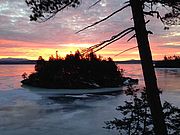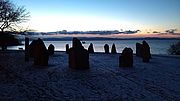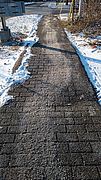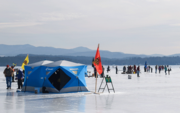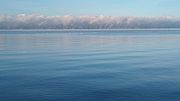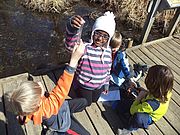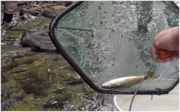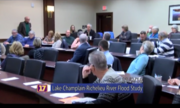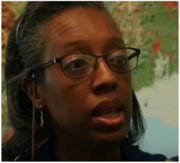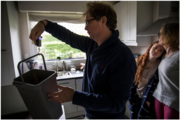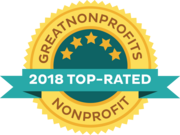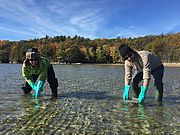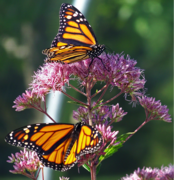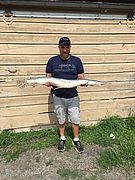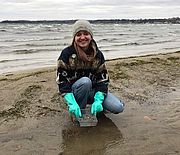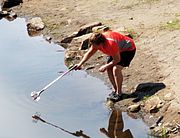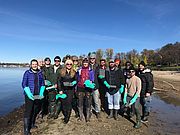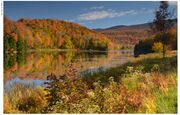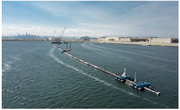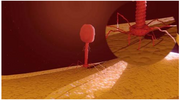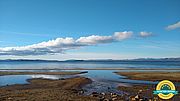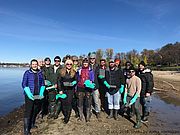After winter storm Harper dumped over two feet of snow in parts of the Lake Champlain watershed, followed by more precipitation in the form of freezing rain, the roads were slick from both snow and ice. The few cars braving the weather might find themselves outnumbered by plows, earthmovers, and dump trucks. While the sudden appearance of plows and clear roads after a storm may seem like magic, the snow removal process takes careful planning. Even before the Lake Champlain basin’s heavy snow comes down, or freezing rain coats the roads, municipalities are already swinging into action.
News from Selected Category
In the midst of winter changes there is a lake phenomenon that seems more at home in the extreme cold of the arctic than familiar Lake Champlain. Commonly called ice volcanoes, this phenomenon is unique to large northern lakes and oceans, where powerful waves send “eruptions” of water through the ice.
100,000 years ago, winter in the Champlain valley was a lot longer. The last glaciers of the ice age filled the Green and Adirondack Mountains, carrying vast amounts of earth that scraped the land like sandpaper, deepening the valley that would one day hold Lake Champlain.
Winters on Lake Champlain are known for their long hours of darkness. As the sun sets earlier each afternoon, and rises later each morning, those who have settled in this valley may begin to feel the days blend together into one long winter’s night.
Salt is the ubiquitous solution to icy roads and sidewalks, but it isn’t the only way you can keep from slipping during the winter. Excessive use of salt damages plants’ ability to absorb nutrients, and can affect aquatic life if it’s washed into a water body.
Want to try ice fishing for the first time or improve your skills? Come out to Knight Point State Park, North Hero, VT any time from 11:00 AM to 3:00 PM on Saturday January 26 where the VT Fish and Wildlife Department will host a free ice fishing festival. Fishing is free and no licenses are required for fishing any of the state’s waters that day!Read...
Join LCC, ECHO, and other members of the Clean Water Policy Network on Monday (1/28/19) morning for a discussion of clean water issues and upcoming legislation. The January forum in Montpelier provides participants with a preview of issues, legislation, and regulatory initiatives in the coming session.
World Water Day celebrates the importance of water around the world. In the Lake Champlain watershed we will be celebrating World Water Day on March 21, 2019 with a K-12 student contest! The contest will be hosted at the Main Street Landing Performing Arts Center in Burlington, VT. All student submissions of original art, videos, photography, and writing will be gathered for public viewing from 4:00 – 6:30 PM, awards will be given to winning submissions, and guest speaker Dr. Danielle Garneau, Associate Professor of Environmental Science at SUNY Plattsburgh, will present on “Plastics in Lake Champlain: How you can help”.
Biologists in Montpelier, VT question if a warm, dry fall is to blame for a drop in the Lake Champlain watershed’s landlocked salmon population – or whether there’s another reason. Salmon in the region have been declining for the past five years, and in 2018 their population was the lowest it’s been since 2009.
Recent public meetings were held to provide an update and get citizen input on the Lake Champlain-Richelieu River Flood Study which began in 2017 and will be completed in 2021. LCC’s Executive Director serves on the Public Advisory Group for the study. If you missed these meetings you can catch up on developments by watching the one held in Vermont online!
A mass die-off has caused many of the invasive alewife fish to wash up at Rossetti park just before New Year. Thousands of the tiny herring coated 100 square feet of the lake’s waterline. According to VT Fish and Wildlife fishery scientist Shawn Good, the die-off is the natural result of the alewife’s sensitivity to fluctuations in temperature. Colchester Sun.
Vermont State climatologist Lesleay-Ann Dupigny-Giroux answers pressing questions about the effects climate change will have on the Northeast. Dupigny-Giroux contributed to the Fourth National Climate Assessment as the lead author of the Northeast chapter. The National Climate Assessment was a report published on November 23, 2018, which focused on environmental, human health, and economic impacts of climate change in the U.S. VT Digger.
“PARCHMENT, Mich. — The day this small town told its residents to stop drinking the water, life on Glendale Boulevard turned from quiet to alarming.” For years calls for polyfluoroalkyl and perfluoroalkyl substances, or PFAS, to be federally regulated have gone unanswered. This summer one more small town paid the price. Washington Post.
“Dr. Natalia Ivleva, a researcher with the Technical University of Munich (TUM), has developed new analytical methods for the identification and quantification of microplastic. In this interview, she shares her latest findings.” Environmental News Network.
“Most people’s New Year’s resolutions are all about self-improvement: exercising more, saving money, learning new skills. This year, enlist your family in a group resolution: reducing your single-use plastic waste.” National Geographic.
The fishhook waterflea was discovered near Valcour Island in September, making it the fifty-first known invasive species to date in Lake Champlain. The discovery was made by Plattsburgh SUNY’s Lake Champlain Research Institute (LCRI) at an established Lake Champlain Long-term Biological Monitoring Program site supported by the Lake Champlain Basin Program. Analysis of the water samples by LCRI’s Dr. Tim Mihuc and his staff confirmed high densities of over 100 individual fishhook waterfleas per sample.
The Lake Champlain Committee (LCC) has been named a “2018 Top-Rated Nonprofit” by GreatNonprofits, the leading provider of user reviews of charities and nonprofits. LCC uses science-based advocacy, education and collaborative action to protect water quality, safeguard habitats, provide access, and foster stewardship in the Lake Champlain watershed.
It was a sunny, crisp October morning. The rainy grey mist from the week before had cleared to reveal a stunning panorama of mountains, lake, and sand. On a beach just north of Burlington LCC staff and volunteers and a crew from Magic Hat Brewery, bundled in warm layers against the morning chill, arranged in a staggered line. Those with muck boots waded through the shallow water, while the others walked along the shoreline. Every few paces each stopped to kneel and scoop up sand in a small metal sieve. They then shook away the sand, as if panning for gold, examined the contents briefly – and discarded them.
Interested in Lake Champlain’s past, present and future? Sign up soon to join LCC at The Lake Between (Le lac qui nous unit) – an International Conference designed to bring together academics, business leaders, policy-makers, outdoor enthusiasts, boaters and swimmers, musicians and artists to talk about the lake.
The Nature note below is written by Laura Pratt, LCC’s new ECO AmeriCorps Education & Outreach Coordinator. Monarchs left the Lake Champlain watershed in September as temperatures dropped and the milkweed died back. Both factors drive their migration as they can’t survive low temperatures or reproduce without milkweed. Their destination? The oyamel fir forests north of Mexico City where all monarchs east of the Rocky Mountains migrate for winter. The butterflies that survived the journey from the Champlain Valley should be arriving in Mexico throughout November.
On August 18 of this year, a man fishing for channel catfish in Lake Champlain’s South Bay reeled in a record-breaking longnose gar instead. The big fish was 52 and ¼ inches long and weighed in at 14 pounds 10 ounces, besting the 1999 New York state record by one and a half pounds.
Laura Pratt is LCC’s newest ECO AmeriCorps Education & Outreach Coordinator. She joined LCC in September and picks up on the service of Dominic Brennan and Daniel Denora who preceded her in the eleven-month position.
Deep thanks to all our cyanobacteria monitors for their diligent work during the 2018 season. Many began assessing site conditions in mid-June and filed their final report 19 weeks later in mid-October. LCC monitors and our partners at the Vermont and New York Departments of Health and Environmental Conservation gathered data from nearly 150 sites in the Lake Champlain watershed and filed more than 1,800 reports about water conditions.
For several years, Magic Hat Brewing Company has been funding LCC programs, promoting our work for clean water with special lake brews, and providing volunteer assistance for special projects. Our latest collaboration was a two-day session to search for Asian clams, an invasive mollusk that’s been found in nearby waterways.
WCAX TV - "A shorebird with an intense appetite and destructive droppings is on the decline in Lake Champlain. A multi-year effort by Vermont Fish and Wildlife, the New York DEC, and private land owners to reduce the cormorant population appears to be paying off."
The Trust for Public Land - "The Trust for Public Land conducted an economic analysis and found that every $1 invested in land conservation by the state returns $9 in economic value in natural goods and services, such as water quality protection, flood mitigation, and food production, to the Vermont economy."
The New York Times - "A multimillion-dollar floating boom designed to corral plastic debris littering the Pacific Ocean deployed from San Francisco Bay on Saturday as part of a larger high-stakes and ambitious undertaking."
Water World - "To rapidly detect the presence of E. coli in drinking water, Cornell University food scientists now can employ a bacteriophage - -a genetically engineered virus -- in a test used in hard-to-reach areas around the world."
Today is GivingTuesday, the "Black Friday" for charitable giving and part of an international movement to create a day of giving back. Please consider participating by making a gift of time or money to the Lake Champlain Committee.
It was a sunny, crisp October morning. The rainy grey mist from the week before had cleared to reveal a stunning panorama of mountains, lake, and sand. On a beach just north of Burlington a group of volunteers, bundled in warm layers against the morning chill, were ranged in a staggered line. Those with muck boots waded through the shallow water, while the others walked along the shoreline. Every few paces each stopped to kneel and scoop up sand in a small steel sieve. They then shook away the sand, as if panning for gold, examined the contents briefly – and discarded them.
